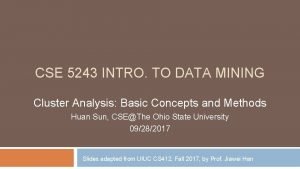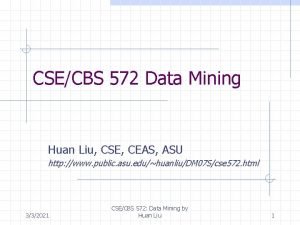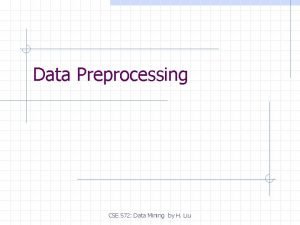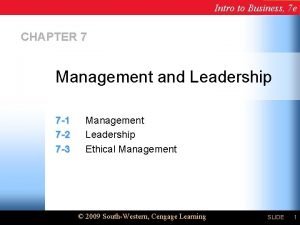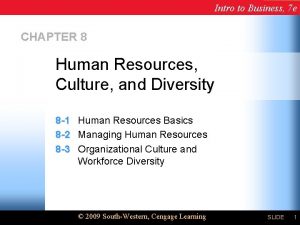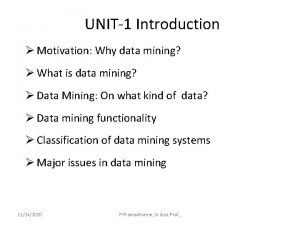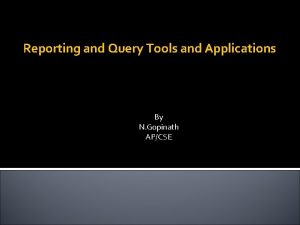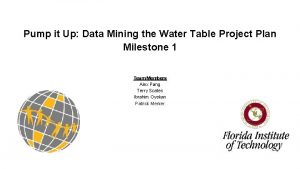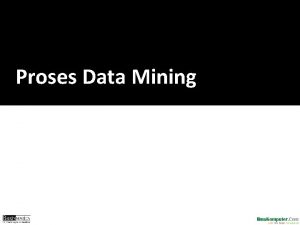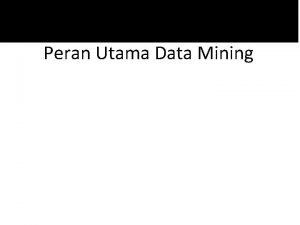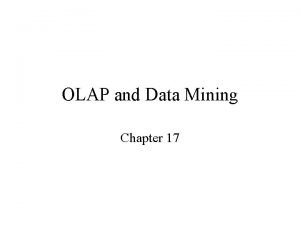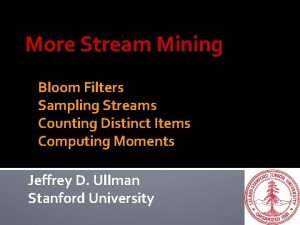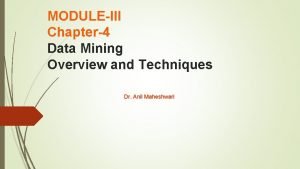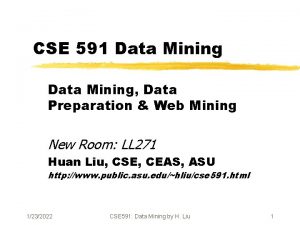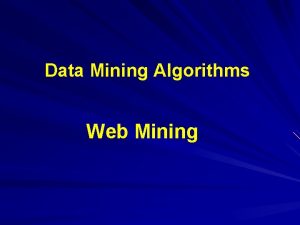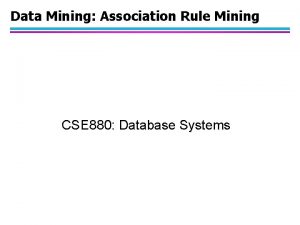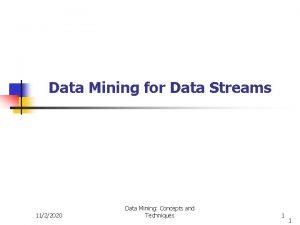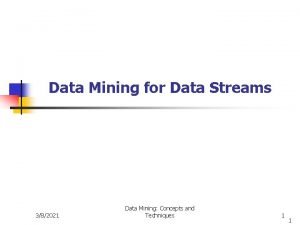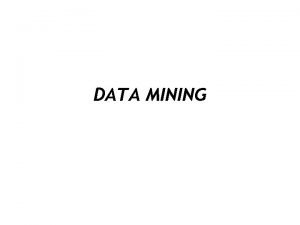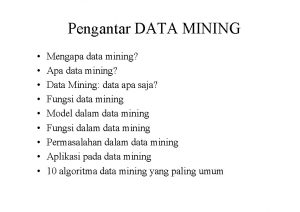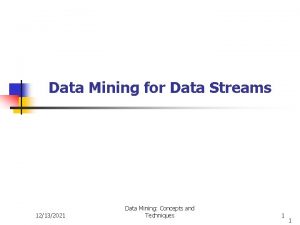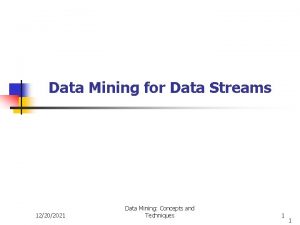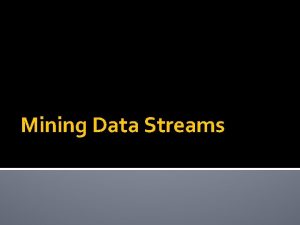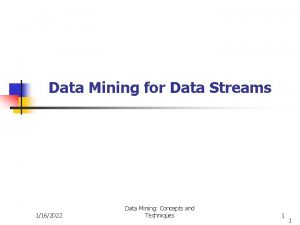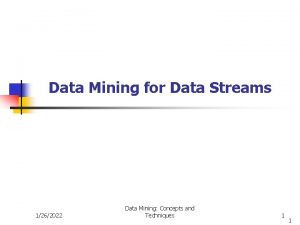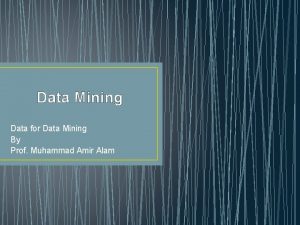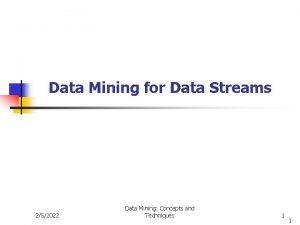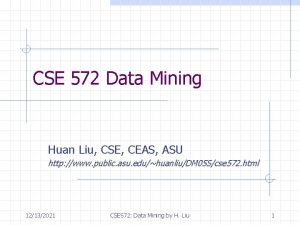CSE 5243 INTRO TO DATA MINING Chapter 1














































- Slides: 46

CSE 5243 INTRO. TO DATA MINING Chapter 1. Introduction Huan Sun, CSE@The Ohio State University Slides adapted from UIUC CS 412, Fall 2017, by Prof. Jiawei Han

CSE 5243. Course Page & Schedule Class Homepage: http: //web. cse. ohio-state. edu/~sun. 397/courses/au 2017/cse 5243 new. html 2 Class Schedule: 9: 35 -10: 55 AM, Tue/Thur, Bolz Hall 318 Office hours: � Instructor: Huan Sun @DL 699, Tue 4: 30 -5: 30 PM � Grader: Yu Wang, wang. 5205@osu. edu , By appointment

CSE 5243. Textbook � Jiawei Han, Micheline Kamber and Jian Pei, Data Mining: Concepts and Techniques (3 rd ed), 2011 � Pang-Ning Tan, Michael Steinbach, and Vipin Kumar, Introduction to Data Mining, 2006 � Mohammed J. Zaki and Wagner Meira, Jr. , Data Mining Analysis and Concepts, 2014 � Jure Leskovec, Anand Rajaraman, Jeff Ullman, Mining of Massive Datasets 3 More resources: https: //wiki. illinois. edu//wiki/display/cs 412/2. +Course+Syllabus+and+Sch edule More resources: http: //www. mmds. org/

CSE 5243. Course Work and Grading Homework, Course Projects, and Exams � Participation: 10% (Class attendance is critical) � Homework: 50% (No Late Submissions!) � Midterm exam: 20% � Final project: 20% Need help and/or discussions? � Sign on: Piazza (piazza. com/osu/autumn 2017/au 175243) 4 Receive credits: answering questions related to the homework on Piazza and engaging in class discussion.

Chapter 1. Introduction 5 What Is Data Mining? Why Data Mining? A Multi-Dimensional View of Data Mining What Kinds of Data Can Be Mined? What Kinds of Patterns Can Be Mined? What Kinds of Technologies Are Used? What Kinds of Applications Are Targeted? Major Issues in Data Mining A Brief History of Data Mining and Data Mining Society Summary

What is Data Mining? Data mining (knowledge discovery from data) � Extraction of interesting (non-trivial, implicit, previously unknown and potentially useful) patterns or knowledge from huge amount of data � Data mining: a misnomer? Alternative names � Knowledge discovery (mining) in databases (KDD), knowledge extraction, data/pattern analysis, data archeology, data dredging, information harvesting, business intelligence, etc. 6

Knowledge Discovery (KDD) Process This is a view from typical database systems and data warehousing communities Pattern Evaluation Data mining plays an essential role in the knowledge discovery process Data Mining Task-relevant Data Warehouse Data Cleaning 7 Selection Data Integration Databases

Example: A Web Mining Framework Web mining usually involves � Data cleaning � Data integration from multiple sources � Warehousing the data � Data cube construction � Data selection for data mining � Data mining � Presentation � Patterns of the mining results and knowledge to be used or stored into knowledge-base 8

Data Mining in Business Intelligence Increasing potential to support business decisions Decision Making Data Presentation Visualization Techniques Data Mining Information Discovery End User Business Analyst Data Exploration Statistical Summary, Querying, and Reporting Data Preprocessing/Integration, Data Warehouses Data Sources Paper, documents, Scientific experiments, Database Systems 9 DBA

KDD Process: A View from ML and Statistics Input Data Pre. Processing Data integration Normalization Feature selection Dimension reduction Data Mining Pattern discovery Classification Clustering Outlier analysis ………… Pattern evaluation selection interpretation visualization This is a view from typical machine learning and statistics communities 10 Post. Processing

Data Mining vs. Data Exploration Which view do you prefer? � KDD vs. ML/Stat. vs. Business Intelligence � Depending on the data, applications, and your focus Data Mining vs. Data Exploration � Business intelligence view Warehouse, � Business � Supply data cube, reporting but not much mining objects vs. data mining tools chain example: mining vs. OLAP vs. presentation tools � Data 11 presentation vs. data exploration

Chapter 1. Introduction 12 What Is Data Mining? Why Data Mining? A Multi-Dimensional View of Data Mining What Kinds of Data Can Be Mined? What Kinds of Patterns Can Be Mined? What Kinds of Technologies Are Used? What Kinds of Applications Are Targeted? Major Issues in Data Mining A Brief History of Data Mining and Data Mining Society Summary

Why Data Mining? The Explosive Growth of Data: from terabytes to petabytes � Data collection and data availability 13 Automated data collection tools, database systems, Web, computerized society

Why Data Mining? The Explosive Growth of Data: from terabytes to petabytes � Data collection and data availability � 14 Automated data collection tools, database systems, Web, computerized society Major sources of abundant data Business: Web, e-commerce, transactions, stocks, … Science: Remote sensing, bioinformatics, scientific simulation, … Society and everyone: news, digital cameras, You. Tube

Why Data Mining? The Explosive Growth of Data: from terabytes to petabytes � Data collection and data availability � 15 Automated data collection tools, database systems, Web, computerized society Major sources of abundant data Business: Web, e-commerce, transactions, stocks, … Science: Remote sensing, bioinformatics, scientific simulation, … Society and everyone: news, digital cameras, You. Tube We are drowning in data, but starving for knowledge! “Necessity is the mother of invention”—Data mining— Automated analysis of massive data sets

Chapter 1. Introduction 16 Why Data Mining? What Is Data Mining? A Multi-Dimensional View of Data Mining What Kinds of Data Can Be Mined? What Kinds of Patterns Can Be Mined? What Kinds of Technologies Are Used? What Kinds of Applications Are Targeted? Major Issues in Data Mining A Brief History of Data Mining and Data Mining Society Summary

Multi-Dimensional View of Data Mining Data to be mined � Knowledge to be mined (or: Data mining functions) � Characterization, discrimination, association, classification, clustering, trend/deviation, outlier analysis, … � Descriptive vs. predictive data mining � Multiple/integrated functions and mining at multiple levels Techniques utilized � Data-intensive, data warehouse (OLAP), machine learning, statistics, pattern recognition, visualization, high-performance, etc. Applications adapted � 17 Database data (extended-relational, object-oriented, heterogeneous), data warehouse, transactional data, stream, spatiotemporal, time-series, sequence, text and web, multi-media, graphs & social and information networks Retail, telecommunication, banking, fraud analysis, bio-data mining, stock market analysis, text mining, Web mining, etc.

Chapter 1. Introduction 18 Why Data Mining? What Is Data Mining? A Multi-Dimensional View of Data Mining What Kinds of Data Can Be Mined? What Kinds of Patterns Can Be Mined? What Kinds of Technologies Are Used? What Kinds of Applications Are Targeted? Major Issues in Data Mining A Brief History of Data Mining and Data Mining Society Summary

Data Mining: On What Kinds of Data? 19 Database-oriented data sets and applications � Relational database, data warehouse, transactional database � Object-relational databases, Heterogeneous databases and legacy databases Advanced data sets and advanced applications � Data streams and sensor data � Time-series data, temporal data, sequence data (incl. biosequences) � Structure data, graphs, social networks and information networks � Spatial data and spatiotemporal data � Multimedia database � Text databases

Chapter 1. Introduction 20 Why Data Mining? What Is Data Mining? A Multi-Dimensional View of Data Mining What Kinds of Data Can Be Mined? What Kinds of Patterns Can Be Mined? What Kinds of Technologies Are Used? What Kinds of Applications Are Targeted? Major Issues in Data Mining A Brief History of Data Mining and Data Mining Society Summary

Data Mining Functions: (1) Generalization Information integration and data warehouse construction � 21 Data cleaning, transformation, integration, and multidimensional data model

Data Mining Functions: (1) Generalization 22 Data cube technology � Scalable methods for computing (i. e. , materializing) multidimensional aggregates � OLAP (online analytical processing)

Data Mining Functions: (1) Generalization Information integration and data warehouse construction � Data cleaning, transformation, integration, and multidimensional data model Data cube technology � Scalable methods for computing (i. e. , materializing) multidimensional aggregates � OLAP (online analytical processing) Multidimensional concept description: Characterization and discrimination � Generalize, summarize, and contrast data characteristics, e. g. , dry vs. wet region 23

Data Mining Functions: (2) Pattern Discovery q Frequent patterns (or frequent itemsets) � What items are frequently purchased together in your Walmart? Association and Correlation Analysis A typical association rule q Diaper Beer [0. 5%, 75%] (support, confidence) Are strongly associated items also strongly correlated? How to mine such patterns and rules efficiently in large datasets? How to use such patterns for classification, clustering, and other applications? q q q 24

Data Mining Functions: (3) Classification 25 Classification and label prediction � Construct models (functions) based on some training examples � Describe and distinguish classes or concepts for future prediction Ex. 1. Classify countries based on (climate) Ex. 2. Classify cars based on (gas mileage) � Predict some unknown class labels Typical methods � Decision trees, naïve Bayesian classification, support vector machines, neural networks, rule-based classification, pattern-based classification, logistic regression, … Typical applications: � Credit card fraud detection, direct marketing, classifying

Data Mining Functions: (4) Cluster Analysis 26 Unsupervised learning (i. e. , Class label is unknown) Group data to form new categories (i. e. , clusters), e. g. , cluster houses to find distribution patterns Principle: Maximizing intraclass similarity & minimizing interclass similarity Many methods and applications

Data Mining Functions: (5) Outlier Analysis 27 Outlier analysis � Outlier: A data object that does not comply with the general behavior of the data � Noise or exception? ―One person’s garbage could be another person’s treasure � Methods: by product of clustering or regression analysis, … � Useful in fraud detection, rare events analysis

Data Mining Functions: (6) Time and Ordering: Sequential Pattern, Trend and Evolution Analysis 28 Sequence, trend and evolution analysis � Trend, time-series, and deviation analysis e. g. , regression and value prediction � Sequential pattern mining e. g. , buy digital camera, then buy large memory cards � Periodicity analysis � Motifs and biological sequence analysis Approximate and consecutive motifs � Similarity-based analysis Mining data streams � Ordered, time-varying, potentially infinite, data streams

Data Mining Functions: (7) Structure and Network Analysis 29 Graph mining � Finding frequent subgraphs (e. g. , chemical compounds), trees (XML), substructures (web fragments) Information network analysis � Social networks: actors (objects, nodes) and relationships (edges) e. g. , author networks in CS, terrorist networks � Multiple heterogeneous networks A person could be multiple information networks: friends, family, classmates, … � Links carry a lot of semantic information: Link mining Web mining � Web is a big information network: from Page. Rank to Google � Analysis of Web information networks Web community discovery, opinion mining, usage mining, …

Evaluation of Knowledge 30 Are all mined knowledge interesting? � One can mine tremendous amount of “patterns” � Some may fit only certain dimension space (time, location, …) � Some may not be representative, may be transient, … Evaluation of mined knowledge → directly mine only interesting knowledge? � Descriptive vs. predictive � Coverage � Typicality vs. novelty � Accuracy � Timeliness � …

Chapter 1. Introduction 31 Why Data Mining? What Is Data Mining? A Multi-Dimensional View of Data Mining What Kinds of Data Can Be Mined? What Kinds of Patterns Can Be Mined? What Kinds of Technologies Are Used? What Kinds of Applications Are Targeted? Major Issues in Data Mining A Brief History of Data Mining and Data Mining Society Summary

Data Mining: Confluence of Multiple Disciplines Machine Learning Applications Algorithm 32 Pattern Recognition Data Mining Database Technology Statistics Visualization High-Performance Computing

Why Confluence of Multiple Disciplines? 33 Tremendous amount of data � Algorithms must be scalable to handle big data High-dimensionality of data � Micro-array may have tens of thousands of dimensions High complexity of data � Data streams and sensor data � Time-series data, temporal data, sequence data � Structure data, graphs, social and information networks � Spatial, spatiotemporal, multimedia, text and Web data � Software programs, scientific simulations

Chapter 1. Introduction 34 Why Data Mining? What Is Data Mining? A Multi-Dimensional View of Data Mining What Kinds of Data Can Be Mined? What Kinds of Patterns Can Be Mined? What Kinds of Technologies Are Used? What Kinds of Applications Are Targeted? Major Issues in Data Mining A Brief History of Data Mining and Data Mining Society Summary

Applications of Data Mining Web page analysis: classification, clustering, ranking Collaborative analysis & recommender systems Basket data analysis to targeted marketing Biological and medical data analysis Data mining and software engineering Data mining and text analysis Data mining and social and information network analysis Built-in (invisible data mining) functions in Google, MS, Yahoo!, Linked, Facebook, … Major dedicated data mining systems/tools � 35 SAS, MS SQL-Server Analysis Manager, Oracle Data Mining Tools)

Chapter 1. Introduction 36 Why Data Mining? What Is Data Mining? A Multi-Dimensional View of Data Mining What Kinds of Data Can Be Mined? What Kinds of Patterns Can Be Mined? What Kinds of Technologies Are Used? What Kinds of Applications Are Targeted? Major Issues in Data Mining A Brief History of Data Mining and Data Mining Society Summary

Major Issues in Data Mining (1) 37 Mining Methodology � Mining various and new kinds of knowledge � Mining knowledge in multi-dimensional space � Data mining: An interdisciplinary effort � Boosting the power of discovery in a networked environment � Handling noise, uncertainty, and incompleteness of data � Pattern evaluation and pattern- or constraint-guided mining User Interaction � Interactive mining � Incorporation of background knowledge

Major Issues in Data Mining (2) 38 Efficiency and Scalability � Efficiency and scalability of data mining algorithms � Parallel, distributed, stream, and incremental mining methods Diversity of data types � Handling complex types of data � Mining dynamic, networked, and global data repositories Data mining and society � Social impacts of data mining � Privacy-preserving data mining � Invisible data mining

Chapter 1. Introduction 39 Why Data Mining? What Is Data Mining? A Multi-Dimensional View of Data Mining What Kinds of Data Can Be Mined? What Kinds of Patterns Can Be Mined? What Kinds of Technologies Are Used? What Kinds of Applications Are Targeted? Major Issues in Data Mining A Brief History of Data Mining and Data Mining Society Summary

A Brief History of Data Mining Society 40 1989 IJCAI Workshop on Knowledge Discovery in Databases � Knowledge Discovery in Databases (G. Piatetsky-Shapiro and W. Frawley, 1991) 1991 -1994 Workshops on Knowledge Discovery in Databases � Advances in Knowledge Discovery and Data Mining (U. Fayyad, G. Piatetsky-Shapiro, P. Smyth, and R. Uthurusamy, 1996) 1995 -1998 International Conferences on Knowledge Discovery in Databases and Data Mining (KDD’ 95 -98) � Journal of Data Mining and Knowledge Discovery (1997) ACM SIGKDD conferences since 1998 and SIGKDD Explorations More conferences on data mining � PAKDD (1997), PKDD (1997), SIAM-Data Mining (2001), (IEEE) ICDM (2001), WSDM (2008), etc. ACM Transactions on KDD (2007)

Conferences and Journals on Data Mining 41 KDD Conferences � ACM SIGKDD Int. Conf. on Knowledge Discovery in Databases and Data Mining (KDD) � SIAM Data Mining Conf. (SDM) � (IEEE) Int. Conf. on Data Mining (ICDM) � European Conf. on Machine Learning and Principles and practices of Knowledge Discovery and Data Mining (ECML-PKDD) � Pacific-Asia Conf. on Knowledge Discovery and Other related conferences DB conferences: ACM SIGMOD, VLDB, ICDE, EDBT, ICDT, … Web and IR conferences: WWW, SIGIR, WSDM ML conferences: ICML, NIPS PR conferences: CVPR, Journals Data Mining and Knowledge Discovery (DAMI or DMKD) IEEE Trans. On Knowledge and Data Eng. (TKDE) KDD Explorations ACM Trans. on KDD

Where to Find References? DBLP, Cite. Seer, Google 42 Data mining and KDD (SIGKDD) � Conferences: ACM-SIGKDD, IEEE-ICDM, SIAM-DM, PKDD, PAKDD, etc. � Journal: Data Mining and Knowledge Discovery, KDD Explorations, ACM TKDD Database systems (SIGMOD) � Conferences: ACM-SIGMOD, ACM-PODS, VLDB, IEEE-ICDE, EDBT, ICDT, DASFAA � Journals: IEEE-TKDE, ACM-TODS/TOIS, JIIS, J. ACM, VLDB J. , Info. Sys. , etc. AI & Machine Learning � Conferences: Machine learning (ML), AAAI, IJCAI, COLT (Learning Theory), CVPR, NIPS, etc. � Journals: Machine Learning, Artificial Intelligence, Knowledge and

Where to Find References? DBLP, Cite. Seer, Google 43 Web and IR � Conferences: SIGIR, WWW, CIKM, etc. � Journals: WWW: Internet and Web Information Systems Statistics � Conferences: Joint Stat. Meeting, etc. � Journals: Annals of statistics, etc. Visualization � Conference proceedings: CHI, ACM-SIGGraph, etc. � Journals: IEEE Trans. visualization and computer graphics, etc.

Chapter 1. Introduction 44 Why Data Mining? What Is Data Mining? A Multi-Dimensional View of Data Mining What Kinds of Data Can Be Mined? What Kinds of Patterns Can Be Mined? What Kinds of Technologies Are Used? What Kinds of Applications Are Targeted? Major Issues in Data Mining A Brief History of Data Mining and Data Mining Society Summary

Summary 45 Data mining: Discovering interesting patterns and knowledge from massive amount of data A natural evolution of science and information technology, in great demand, with wide applications A KDD process includes data cleaning, data integration, data selection, transformation, data mining, pattern evaluation, and knowledge presentation Mining can be performed in a variety of data Data mining functionalities: characterization, discrimination, association, classification, clustering, trend and outlier analysis, etc. Data mining technologies and applications

Recommended Reference Books 46 Charu C. Aggarwal, Data Mining: The Textbook, Springer, 2015 E. Alpaydin. Introduction to Machine Learning, 2 nd ed. , MIT Press, 2011 R. O. Duda, P. E. Hart, and D. G. Stork, Pattern Classification, 2 ed. , Wiley-Interscience, 2000 U. Fayyad, G. Grinstein, and A. Wierse, Information Visualization in Data Mining and Knowledge Discovery, Morgan Kaufmann, 2001 J. Han, M. Kamber, and J. Pei, Data Mining: Concepts and Techniques. Morgan Kaufmann, 3 rd ed. , 2011 T. Hastie, R. Tibshirani, and J. Friedman, The Elements of Statistical Learning: Data Mining, Inference, and Prediction, 2 nd ed. , Springer, 2009 T. M. Mitchell, Machine Learning, Mc. Graw Hill, 1997 P. -N. Tan, M. Steinbach and V. Kumar, Introduction to Data Mining, Wiley, 2005 (2 nd ed. 2016) I. H. Witten and E. Frank, Data Mining: Practical Machine Learning Tools and Techniques with Java Implementations, Morgan Kaufmann, 2 nd ed. 2005 Mohammed J. Zaki and Wagner Meira Jr. , Data Mining and Analysis:
 Cse 5243
Cse 5243 Eck
Eck 5243-2126
5243-2126 Mining multimedia databases in data mining
Mining multimedia databases in data mining Cse 572 data mining
Cse 572 data mining Cse 572 data mining
Cse 572 data mining Strip mining vs open pit mining
Strip mining vs open pit mining Strip mining vs open pit mining
Strip mining vs open pit mining Difference between strip mining and open pit mining
Difference between strip mining and open pit mining Difference between text mining and web mining
Difference between text mining and web mining Data reduction in data mining
Data reduction in data mining What is data mining and data warehousing
What is data mining and data warehousing What is missing data in data mining
What is missing data in data mining Concept hierarchy generation for nominal data
Concept hierarchy generation for nominal data Data reduction in data mining
Data reduction in data mining Data reduction in data mining
Data reduction in data mining Data cube technology in data mining
Data cube technology in data mining Data reduction in data mining
Data reduction in data mining Arsitektur data mining
Arsitektur data mining Data mining dan data warehouse
Data mining dan data warehouse Data warehousing and data mining in crm
Data warehousing and data mining in crm Descriptive mining of complex data objects
Descriptive mining of complex data objects Olap data mining
Olap data mining Noisy data in data mining
Noisy data in data mining Data warehouse architecture types
Data warehouse architecture types Markku roiha
Markku roiha Data compression in data mining
Data compression in data mining Introduction to data warehousing and data mining
Introduction to data warehousing and data mining Data warehouse dan data mining
Data warehouse dan data mining Cs 412 introduction to data mining
Cs 412 introduction to data mining Chapter 10 marketing answer key
Chapter 10 marketing answer key Intro to business chapter 7 study guide
Intro to business chapter 7 study guide Introduction to business chapter 8
Introduction to business chapter 8 S2atp
S2atp Chapter 1 introduction to forensic science and the law
Chapter 1 introduction to forensic science and the law Intro to business chapter 10
Intro to business chapter 10 Unsupervised learning in data mining
Unsupervised learning in data mining Data mining motivation
Data mining motivation Data mining concepts and techniques slides
Data mining concepts and techniques slides Query tools in data mining
Query tools in data mining Pump it up: data mining the water table
Pump it up: data mining the water table Sebutkan tahapan utama proses data mining!
Sebutkan tahapan utama proses data mining! Jelaskan perbedaan estimasi dan klasifikasi
Jelaskan perbedaan estimasi dan klasifikasi Olap stands for: *
Olap stands for: * Bloom filter for stream data mining
Bloom filter for stream data mining What are the steps in mining process?
What are the steps in mining process? Data mining exam
Data mining exam
